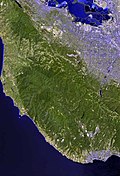
Naples Creek is a stream in San Mateo County, California, United States that rises on the western slopes of the Santa Cruz Mountains and discharges to the Pacific Ocean. The specific point of discharge is onto Naples Beach, a unit of the Half Moon Bay State Beach. This watercourse runs through the city of Half Moon Bay, which municipality has planning jurisdiction over the creekside area within its city boundaries. In the Open Space Element of Half Moon Bay's General Plan, Naples Creek is designated to have significant wetland and riparian zone biotic resources. [1]
Contents
The city of Half Moon Bay is proposing a trail along Naples Creek to expand on the recreational use of this natural resource. The area near the Mouth of Naples Creek is already in public ownership and is traversed by the coastside public trail along the low-lying blufftop. Further upstream along the banks of Naples Creek, the lower reach banks are in public ownership as within the right-of-way of Guerrero Avenue resources. [1] The city recognizes the entire riparian area as an important open space resource and is considering re-zoning to open space the entire passage of the stream through the Half Moon Bay.
